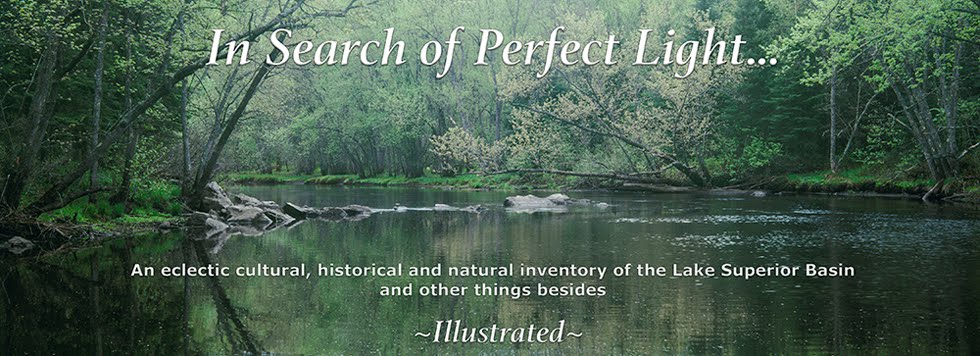Born to a much degraded and long maligned midwestern prairie, I
didn't know jack from wilderness.
Then when still but a kid, we took a family vacation to visit
maternal family on the Gogebic Range, along the Superior Basin.
I saw my first footloose bear where a wild rushing river pours unfettered into a great freshwater sea. They were cubs, like me. On perhaps a different river, a massive rainbow trout leapt into the air and for a moment, glistened like sunlight. I can still sort of see it.
One evening while on our way to fabled fresh fish dinner, a locked & loaded momma skunk stopped traffic in all directions with only the power of suggestion. When all the cute little skunk babies were safely across, she let us pass.
Then there were those northern lights, for one one night only, dancing beyond the bedroom window.
What the hell. A sky!
In situ, I understood the leftover bits of truly awesome oak
savannah I'd explored all my short life and so dearly loved weren't actually 'the woods.'
It took just a few short days in wonderland to know.
As you'll imagine, I was pretty well spoiled for scraggly prairie
remnants after that.
Next time I met Superior was on the cusp of adulthood, traveling with Heather. During that trip, I learned for certain where I
belonged.
Working wild water with 35mm film is how I taught myself to
selectively see the natural world as proscribed by a proscenium stage, captured through a selective lens.
Shooting 35mm transparency taught me film's
limitations. I pushed at those, always.
Occasionally even failures beguiled. In the field that's mostly due to
the splendor of the moment, not any particular skillset…
The best thing about working wild waters was that the work drew
me to them during sublimely quiet times.
On that field you learn to accept what you get and better
luck next time, as needed.
There's no finer time to be alone in the woods at
water's edge than twice daily.
The second best thing is that wild water generally provides
for an inclusive image, as the entire
body of wild life is so well represented in and around it.
Sure, sometimes you can get away with shooting 'just' water.
But as a rule, some visual frame of reference is needed to
keep the viewer anchored in a recognizable landscape.
Even when what's called "the vanishing point" really does.
My love of wild water led me to canoes. As I grew
comfortable in those, my by then ancient Nikon F accompanied me.
Truth is it's a whole different viewpoint out there. Where sometimes even during the best golden hour, no gold's found and you don't want any anyway.
It was Boy Scouts first taught me to be prepared. But being
a field photographer sure reinforced the adage. And in a canoe, you never can
know who'll drop by.
Out there, you're the intruder. But when you're quiet and
respectful, mutual curiosity sometimes prevails.
Plus, the loon's eye perspective often provides the best lakeside
view.
About the image below, a dear friend once told me 'That's it
right there. The Northwoods in a nutshell.'
Or words to that effect.
In any event, over time while wielding my trusty Nikons, I
made myself a fair to decent 35mm landscape photographer.
The best of my young self typically has water of some sort in it.
Yet I grew increasingly dissatisfied with the results.
In
film, size really did matter. Digital capture too, but that's another matter
for a different time.
The deeper I dug into Superior's Northwoods, the more I knew
if I wanted to amount to anything as a fine art field photographer, I'd have to
seriously up my game.
Truth is, even the best 35mm transparency was akin to shooting with toy film. And there were precious few avenues to achieve creative differentiation when working the wild world with that.
There were also millions of 35mm landscape shooters out
there. Every snap shooter's ever lived shoots those, then and now. After a while, we've seen it all.
Years of fieldwork combined with commercial lab expertise
meant I understood both the limitations and the possibilities of my chosen
medium as well or better than most.
By the time I pushed the final roll of 35mm chrome through my
trusty Nikon N90s, I'd also learned to see.
That last day found me caught between hard rock and an even harder place.
Things had to change.


























